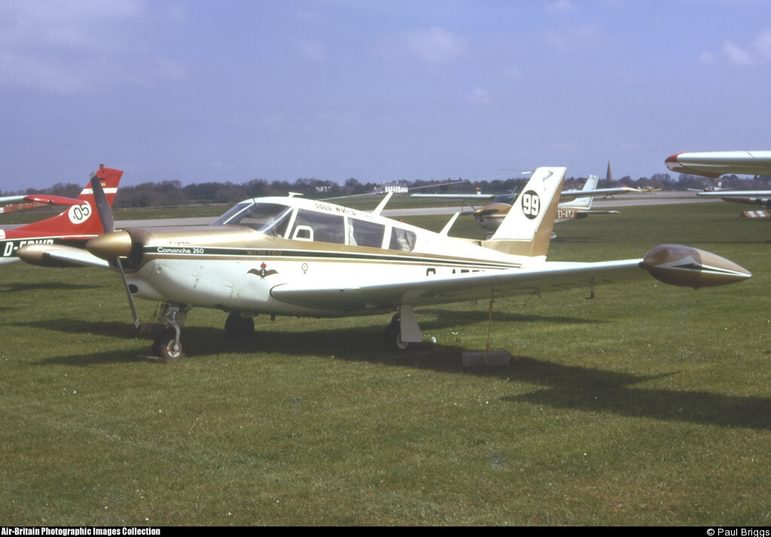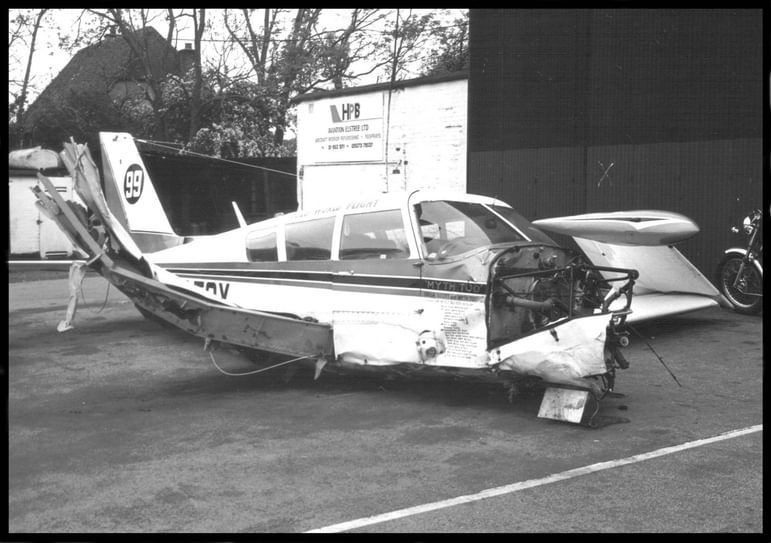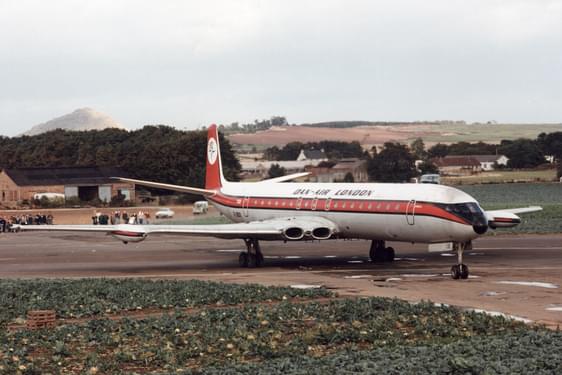
Sheila Scott: The first British pilot to fly around the world
News Story
In 1966 Sheila Scott became the first British pilot to fly around the world.
In May and June 1966 Sheila Scott flew solo around the world in a Piper PA-24-260B Comanche, registration G-ATOY, named 'Myth Too'. This was the first solo round the world flight by a British person and she was only the third woman to fly around the world.
The 'Myth Too' became part of the collections of National Museums Scotland in 1979. Discover the fascinating life of Sheila Scott and her beloved aircraft, the 'Myth Too'.
A life-saver, actor, and pilot
Sheila Scott was born Sheila Christine Hopkins on 27 April 1922 in Worcestershire, England. She served as a nurse at the naval hospital in Gosport during the Second World War. At that time she had a love affair with Peter Korda, son of the film director Alexander Korda. In 1943 she started work as an actor under the name Sheila Scott, initially as a stand-in for Deborah Kerr to whom she bore a passing resemblance. She continued to use this name afterwards.
In September 1958 Sheila started taking flying lessons, achieving her Private Pilot’s Licence the following year. She bought her first aircraft, Thruxton Jackaroo registration G-APAM, and named it 'Myth', the Greek word for a female moth. She entered the 1960 National Air Races and won her first trophy at a rally in Jersey. She qualified for the King’s Cup Air Race that year and gradually set herself greater and greater challenges.
Solo trip round the world
In August 1965 Sheila announced that she would attempt to break the solo round the world record. She had been flying a Piper PA-24-400 Comanche, registration N8515P, named 'Myth Sunpip', on loan from Piper Aircraft for some time. It was this aircraft she was planning to fly in the record attempt. A few weeks before the attempt Scott was made aware that the aircraft's fuel consumption was too high. This posed a risk as the aircraft may run out of fuel over the Pacific Ocean.
Instead, Sheila chose to fly the Piper Comanche 260B G-ATOY. She bought this aircraft in April 1966 with financial help from Sir Alan Cobham. Cobham was a strong advocate of ‘airmindedness’ across Britain. Sheila called the aircraft 'Myth Too'. The Comanche 260 has a lower horsepower engine and could carry more fuel in proportion to its fuel consumption. This made it more suitable for the round the world flight.

The Piper Comanche 260B G-ATOY 'Myth Too' aircraft on an airfield in Jersey, 1975.
Finally, on 18 May 1966, after months of preparations everything was ready. The route took her from London Heathrow – Rome – Athens – Damascus – Bahrain – Karachi – Jaipur – Delhi – Calcutta (Kolkata) – Rangoon – Butterworth – Singapore – Bali – Darwin – Mount Isa – Brisbane – Sydney – Auckland – Norfolk Island – Fiji – East Samoa – Canton Island – Hawaii – San Francisco – Phoenix – El Paso – Oklahoma – Louisville – New York – Gander – Azores – Lisbon and back to London.
As might be expected there were some interesting moments during the trip. Flying through a violent monsoon thunderstorm between Karachi and Delhi and diverting to Jaipur as a result, was one. Another was feeling lonely and anxious in storms over the Tasman Sea only for a flock of light aircraft to appear and accompany Sheila into New Zealand.
One particularly terrifying incident took place over the Pacific Ocean. A fuel tank in the cabin started leaking and the cabin was immersed in fuel, turning 'Myth Too' into a potential flying bomb. Other challenges included suffering from dysentery, many itchy mosquito bites, but perhaps most of all the tiredness of going for days on end without a proper night’s sleep.

Sheila Scott stopping for fuel on the 'Myth Too' during one of her flights.
In this flight Sheila broke the record for the fastest round the world flight. She covered 29,055.14 miles (46,760 km) during 189 flying hours over the course of 34 days. Her average speed was 36.68 mph (59 kph).
Perhaps most difficult of all was what happened on completion of her trip. After landing at London and utterly exhausted, Sheila had to watch 'Myth Too' flown away, without knowing why. This was understandably upsetting. The aircraft would go to Luton to be stripped down and transported by road to the offices of the Daily Mirror newspaper at Holborn Circus. There the aircraft was suspended above the London streets beside a banner that read: “Great Scott. Look what landed at the Mirror!” The aircraft was still dirty with mud from the journey and almost completely covered with signatures from well-wishers who had signed it on the round the world flight.
New celebrity status
Sheila was rather disorientated back in Britain. She found herself a sudden celebrity and had to deal with the fame and attention resulting from her achievement. She attended a succession of banquets and parties in her honour. One of the greatest thrills was the event held by the Variety Club of Great Britain where she met A-list celebrities such as Dame Sybil Thorndike and Anna Neagle. Even more exciting was the invitation to a private luncheon party at Buckingham Palace by Her Majesty Queen Elizabeth. She discussed flying with Prince Philip, himself a qualified pilot.
The flip side to this life of celebrity was that Sheila also had to deal with the large debt to finance the flight. She had many sleepless nights worrying about how to pay these bills whilst also determined to retain ownership of 'Myth Too'. Thanks to the generosity of many benefactors and supporters she was able to do this.
More record-breaking flights
Sheila would go on to plan new record-breaking flights. In 1967 she set out to break the record for flying from London to Cape Town. This would be Sheila’s second record flight. The record was first achieved by Amy Johnson in the 1930s, a heroine of Sheila. Sheila broke the record by four hours.

The 'Myth Too' on a runway in Cape Town, 1967.
Later that year she broke the records for flying the North and South Atlantic solo. This involved flying London – Shannon – Gander – Toronto – Lockhaven – Washington – Grand Bahama – Harbour Cay – Montego Bay – Paramaribo – Natal – Dakar – Rabat – Madrid – London. She also crossed the Atlantic from east to west, following in the airborne footsteps of the R34 airship which made the first such crossing back in 1919.
Sheila continued to fly in various air races and found time to write her autobiography, 'I Must Fly: Adventures of a Woman Pilot'. This was published in 1968. Sadly, neither Airfix nor Meccano were interested in making models of 'Myth Too' due to the “brief topicality of Miss Scott’s flights.”
In 1969-70 Sheila competed in the London to Sydney Air Race, flying 'Myth Too'. She then continued on to complete her second solo round the world flight.
Following this, she began planning for a round the world flight from Pole to Pole but this started with heartbreak. The Piper Comanche did not have sufficient range for the long flight over the Arctic, nor would she have been permitted to do so in a single-engined aircraft. Reluctantly, 'Myth Too' was dropped for a Piper Aztec, registration G-AYTO, named 'Mythre'.
A final farewell
Although she successfully completed another circumnavigation of the globe, the cost of aircraft payments was simply too high for Sheila to afford. With great sadness, she sold Piper Comanche G-ATOY 'Myth Too' in 1971 to Max Coote on behalf of the Lodge Flying Club at Elstree. Max was a model aircraft distributor and also a keen pilot.
Unfortunately, in March 1979 Max crashed whilst flying 'Myth Too'. Thankfully all passengers survived the crash. Sheila went to the crash site to determine the condition of the aircraft:
"Her cabin is intact … but bits of her are scattered over the field, and her wings broken beside her. Her engine and propeller completely wrecked, so we cannot make her fly again. She hardly scarred even the tree she hit."
Sheila Scott

Wreckage of the 'Myth Too' aircraft after its crash in 1979.
Although 'Myth Too' was written-off and would never fly again, the aircraft was given jointly to the Fleet Air Arm Museum and National Museums Scotland in May 1979. Sole ownership was transferred to National Museums Scotland in 1989. The aircraft is on display at the National Museum of Flight in an unrestored state to preserve the originality of the aircraft and its markings.

Sheila Scott with Comanche G-ATOY and museum curators.
Sheila, who was a long-standing cigarette smoker, was diagnosed with lung cancer and died on 20 October 1988.
The Piper PA-24 'Comanche' 260B 'Myth Too' is on display at the National Museum of Flight in the Fantastic Flight gallery.


